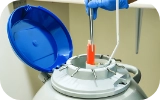One of the main challenges faced in the cooling process is the ice crystal formation. Ice crystals can cause the cell membrane to shred or rupture. In order to avoid this, before freezing, the eggs/embryos are incubated in a solution known as the cryoprotectants which draw out the water from their cells.
Steps involved in vitrification:
- Dehydration of the egg or embryo by exposing it to a high concentration of cryoprotectants
- Loading the egg or embryo into a carrier system.
- The egg or embryo in the carrier system is then rapidly cooled at a very low temperature.
In order to use these vitrified eggs/embryos, they must be dipped in a thawing solution for a few minutes and cleaned later on. This process is known as warming.
What is volume reduction in vitrification?
To decrease the probability of intracellular crystals, the volume of the cryoprotectants used while loading the eggs/embryos into the storage devices must be minimized. This will ensure proper vitrification of the eggs and embryos.
There are many storage devices available in the market. In order to protect the embryos/eggs of any kind of cryoinjury, it is best to choose a device that has low thermal mass and holds a low volume of cryoprotectants. We at Nova, use the cryotops that store eggs/embryos with extremely low volume of cryoprotectants and enable rapid cooling and warming process thus ensuring complete survival of the eggs and embryos.
 Infertility Counselling
Infertility Counselling Female Infertility Treatment
Female Infertility Treatment Andrology Treatment
Andrology Treatment Fertility Enhancing Surgeries - Female
Fertility Enhancing Surgeries - Female Fertility Enhancing Surgeries - Male
Fertility Enhancing Surgeries - Male Endoscopy Treatment
Endoscopy Treatment IUI Treatment
IUI Treatment IVF Treatment
IVF Treatment ICSI Treatment
ICSI Treatment Advanced IVF Solutions
Advanced IVF Solutions Embryology
Embryology Vitrification Egg, Embryo, Sperm Freezing
Vitrification Egg, Embryo, Sperm Freezing Preimplantation Genetic Testing (PGT)
Preimplantation Genetic Testing (PGT) Donation Program Embryo / Egg / Sperm
Donation Program Embryo / Egg / Sperm













